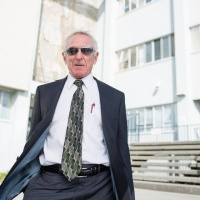
Mr. Voter asks Allan Dollison, Maggie Fleming, Arnie Klein, Elan Firpo…
Homelessness
What is your take on the homeless issues in our county, and what do you see as possible solutions? Is more incarceration a fix?
— Mr. Voter
Responses

Allan Dollison
I have been asked this before at community gatherings so I know it is an issue for the voters of Humboldt County. Homelessness is not a crime, so incarceration to “solve the Homelessness problem” is absolutely not the solution. The Jail is overcrowded as it is. Female inmates that commit violent crimes like Burglary are being released after arrest, because there is no room. I am very concerned that other counties are shipping there homeless to our county. I have spoken to folks within the Dept of Social Services and they have confirmed our high benefits, and free transportation up here are a part of the problem. We have a low-wage, high unemployment economy, and thus it is hard to absorb these people. There are excellent community resources, that can help, people like Pamlyn Milsap from EPD, who are dedicated to our homeless, and works with EPD officers as a liaison. I think as much as possible that these folks need to be re-connected up with their families if they are not from around here. Recently the city of Salt Lake City, UT developed an interesting program to help the Homeless veterans. (See Below) I think some humane treatment is necessary, but we can and should focus on our homegrown homelessness problem and encourage those with little or no roots to not stay here, by providing their transportation back to where they came from. It seems crazy we would have to do that, but perhaps we could approach the legislature and change the requirements to insure a minimum residency requirement to receive benefits, instead of the current system of giving them something right after getting off the bus. http://thinkprogress.org/economy/2014/01/06/3124991/salt-lake-city-homelessness/

Maggie Fleming
More incarceration is not a fix.
However, we can work to strengthen the most effective ways homelessness is being addressed in Humboldt County. These include TAP (Transportation Assistance Program), which provides assistance in helping people return home. I believe that the program is a good one in that people are generally more willing to help others they know. If you see a homeless person and realize you went to high school with him/her, you are probably going to stop and try to see if you can do something. And by providing a homeless person a way to get home the problem that brought about the homelessness may be solved.
Homeless court has long provided an alternative way to deal with crime by the homeless. Instead of fines or jail time, homeless court focuses on community service to resolve cases. I understand from speaking to local business owners that in the past the program has helped to reduce vagrancy in Garberville.
It’s important to recognize that many homeless people face mental health issues. For those individuals, treatment is clearly the best option, but many do not want to participate in treatment. As the person currently handling conservatorship cases for the County, I have seen how placing people with mental health issues on conservatorship can lead to their use of intense services and additional assistance provided by the County. I have seen how intense mental health treatment can end homelessness for some people.

Arnie Klein
This question is a good one. The homeless issue in this community is one that affects all of us, regardless of what we do for a living or what neighborhood we live in.
From my personal observation, however, I’ve come to notice that “homeless” has become a generic term applied to three distinct groups of people who are all quite different and require defining and clarification here.
Group 1 — The Working/Struggling/Unlucky Poor
These are people who often have jobs but are a missed paycheck away from disaster. These people often have children. These people want work and should receive any and all public assistance resources the county has to offer. With the right help, these people can be part of the taxpaying community of people with roofs over their heads. In short, these are people who have no desire to be homeless, and with some help, they can rise above their condition.
Group 2 — Substance Abusers and Those With Mental Health Issues
The second group I’m going to talk about are the chronic substance abusers and those with severe mental health issues. When I started out in law over 40 years ago, we had a robust system in place that didn’t treat our addicts and people with mental health needs like criminals, but with empathy. There was a system in place to get help to those who needed it. After nearly four decades of budget cuts, fiscal re-prioritization and turning a blind eye to those who, without help, really cannot help themselves, our mentally ill now just get thrown into the pile of disregarded people that our society doesn’t really seem to value much. The same could be said about the large number of addicts that are homeless.
About Groups 1 and 2 and the Community
It’s important we distinguish the difference between these first two groups and the last one we are going to address in a moment. Sometimes, the first group, which I will call the working poor, and the second group, specifically the addicts, can overlap. Poverty breeds despair, despair leads to desperation, and a desperate person will do anything to escape the misery of their situation. Unemployed people with no prospects or even a roof over their head are vulnerable to addiction for the reasons I just stated. These are the people who are worth our trouble, who need and deserve our help.
When these people are allowed to fail, as a community we fail. It reflects poorly on all of us when otherwise good people, people who want a chance, who aren’t asking for a handout, are told that there is no place for them here. I’m not sure what as District Attorney, the office can do for these people other than regard them with empathy and deference. When these people run afoul of the law, homeless court and outreach and diversion programs should take priority over prosecution in our criminal courts, provided the transgression isn’t severe enough to warrant otherwise.
Group 3 — The Bums
Now let’s talk about the third group. These people, let’s call them what they are. They are not homeless — they are bums!
What’s a bum? A bum is someone who is perfectly capable of working yet has little or no interest in doing so. We all know who these people are. Arcata even has their own vernacular for these people. They call them plazoids. I don’t know what the people in Garberville call them but they remind me of those characters in the Mad Max movies. These are relatively young, able bodied people who migrated here to Humboldt from comfortable, middle class homes elsewhere. They are here because they heard that the getting is good in Humboldt. The weather is nice, the scenery is beautiful, and the people are friendly. They arrive here willing to do little more than extend their hands out. They feign need yet when just looking at them, one can immediately sense that these young people with an overblown sense of entitlement have confused “need” with want.
These people deserve neither our compassion nor our empathy. These people are what give the first two groups of homeless people a bad name. These people are not struggling with addiction. They don’t suffer from mental health disorders “although they may be quite delusional” and they’re “homelessness” is not the product of failed attempts to find work and bad luck. These people are bums! They don’t want to contribute; they have no ambition. These are people who as a community, we should focus on removing from Humboldt.

Elan Firpo
First, thank you to Loco for providing a format in which candidates can communicate directly with the voters. I will try to respond when I can, but I am currently managing a significant caseload, including a double murder trial. Between work and campaign events, these responses from me are likely to come only on the weekends.
More incarceration is not fix. In fact, it exacerbates our problems by taking up space in the jails where criminals need to be.
The homeless issue overall is a socio-economic issue that relates to the state of our economy, California’s lack of resources for the chronically mentally ill, and a shortage of affordable housing locally. Those are issues that I believe can only be addressed with a broad spectrum of support: law enforcement, mental health, charitable organizations, government services etc. I would like to see a roundtable of person in those fields coming together to bring about creative solutions. I would like to see a social services agency in the lead, but if it doesn’t happen, the District Attorney’s office should assume that lead. This has become a public safety issue.
The District Attorney’s office and “homeless issues” intersect when the homeless commit crimes or are the victims of crime.
I believe in equal protection for ALL citizens of Humboldt. Nobody is above the law. - whether they are homeless or live in a gated community. If a person commits a crime they should be held accountable. On the other hand, I have made sure that homeless victims have their cases prosecuted, because public safety is important to all of us, and the homeless are among the most vulnerable citizens of Humboldt. As someone mentioned in the Operation Safe Streets meeting in Eureka, many of our citizenry are one or two paychecks away from being homeless.
It is in the best interest of any society that we stand up for the extremely vulnerable, whether they are children, the elderly, or the homeless when they are victims of crime.
